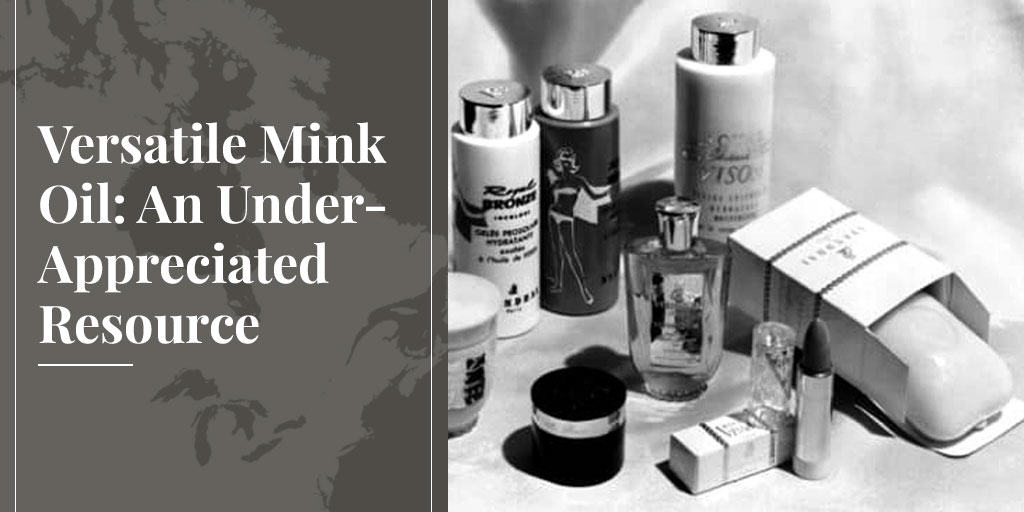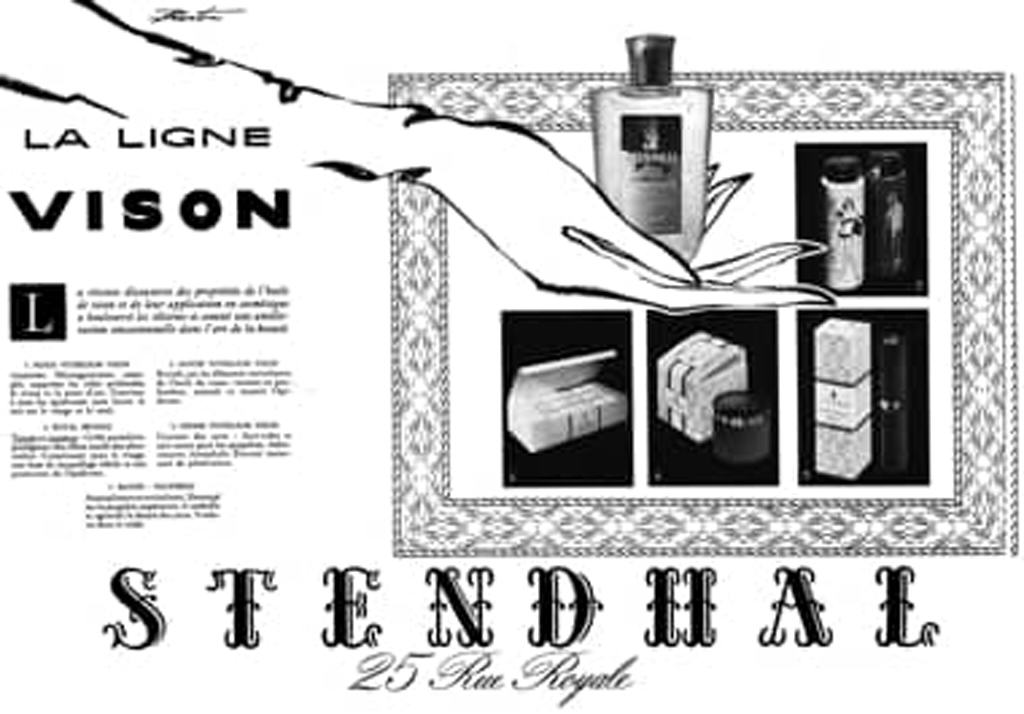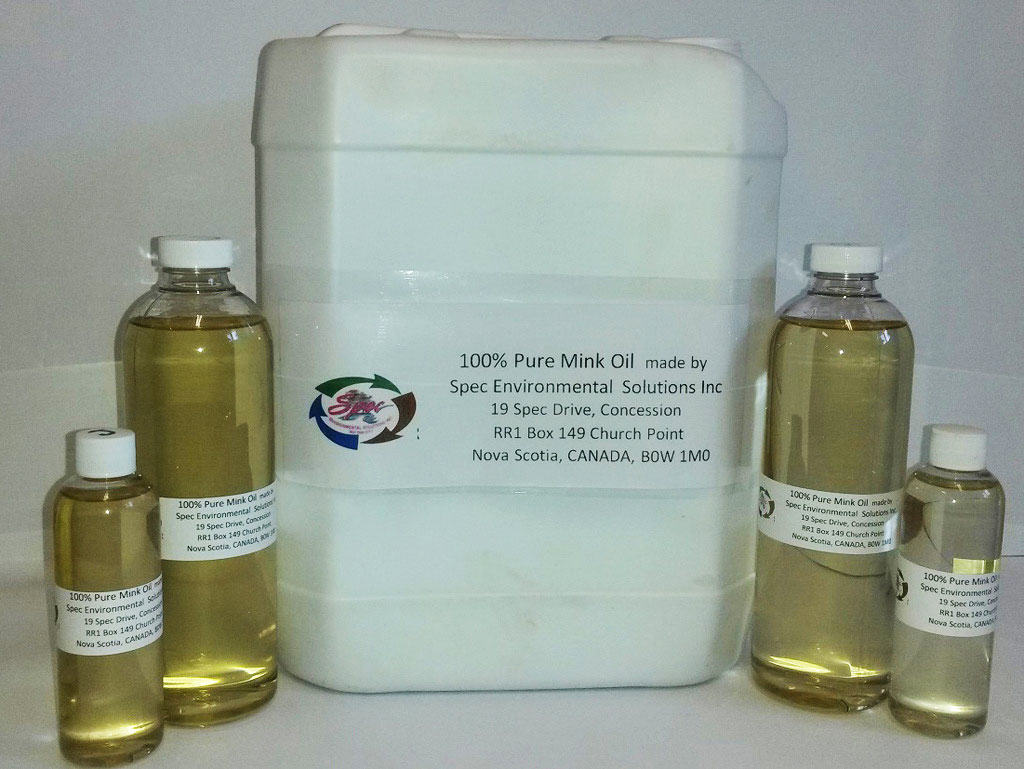
Mink oil is a by-product of fur farming with a curious history that is hugely under-appreciated today. Once touted as a magical tonic for skin and hair, it’s now mostly used for less exotic purposes like leather conditioner and bio-fuel. But if you know where to buy, you can still give your complexion the treat it deserves.
Mink oil comes from the fat on a mink’s abdomen. Most of the fat remains attached to the skin during pelting, and is removed during the “fleshing” process as it can “burn” the fur if not thoroughly scraped off before the pelts are stretched and dried. Each mink yields 200-300 grams (7 to 10.5 ounces) of fat. Just handling this fat tells you it’s special as it melts into a pale-yellow oil that softens and soothes your hands. It’s even more appealing when it’s been purified and deodorised.
Native Americans would have been the first to notice how soft mink fat made their hands, but our story begins in the 1950s. After World War II, mink fur emerged as a fashion favourite, eclipsing the pre-war favourite, fox. Mink farming took off and a steady supply of mink oil was available for the first time. But who would buy it?
An obvious market was soon identified, leather conditioner, and that’s still a major use today. But the marketers had something more exciting in mind: cosmetics. Mink fur already had the luxe image, yearned for by any woman who could afford it or persuade her man to buy it. So the marketers pinned the luxe label on mink oil too, and a new range of beauty products was born.
Mink Oil Beauty Products
This was in keeping with the times. In Europe, the centre then and now of the cosmetics industry, companies were paying chemists to try anything that might unlock the secret to youth, including animal fats and a range of questionable animal extracts – hormones, embryos, placentas. So it really wasn’t surprising when, in 1949, a Paris-based company called Stendhal launched “L’huile de Vison” (The Oil of Mink).
The market was cool at first. Department store R.H. Macy introduced a mink oil cream in 1951 but found it a tough sell, and wondered if women might fear growing fur on their faces!
But things took off in the early 1960s with Stendhal’s “La Ligne Vison” (The Mink Line), featuring mink oil in pure form and in sunscreen, eye shadow, skin cream and soap. Competitors followed suit, adding mink oil to lipstick, cleanser, moisturizer and hair products.

A range of benefits, summarised here by Pureminkoil.com, were claimed:
- Mink oil supplemented human sebum (our natural skin lubricant and waterproofing) very well because its composition is so similar. Our skin absorbs it quickly and deeply because it passes through the pores rather than the epidermis. Our skin is moisturized and nourished, and left velvety to the touch, never sticky or oily. Hard spots are softened, and wrinkles are prevented.
- Mink oil was not associated with any allergies so it was perfect for hypoallergenic cosmetics.
- Mink oil formed a barrier that slowed the loss of both water and sebum from the skin. This meant your skin remained moist for longer after applying makeup.
- Conditioners and sprays containing mink oil increased hair body, suppleness and sheen, and improved the texture of damaged hair.
- Pure mink oil was so stable it could be used for two years after opening a bottle. Cosmetics containing it also stayed fresh longer.
- The mink was the “only animal in the world exempt from suffering any kind of skin diseases,” and this “outstanding ability to heal on its own and their luxurious fur is distinctively related to its nourishing substance stored in its subcutaneous (under the skin) fatty layer of their skin.”
We’re not sure about that last one, but if mink oil cosmetics are so great, why are they hard to find these days? Maybe modern, high-end cosmetics work just as well and are cheaper to make or have a longer shelf life. Maybe also it’s because mink fur lost some of its near-mystical celebrity status in the 1990s, so mink oil’s greatest marketing strength faded too. And perhaps also it’s because consumers, while still valuing natural ingredients in their cosmetics, now often prefer plant extracts to animal sources.
Whatever the case, most mink fat today has a less exotic destiny.
RECOMMENDED READ: Mink oil by Cosmeticsandskin.com
Still Prized
As any livestock farmer knows, efficiency is the key to profits, so it is important to use as much of the animal as possible. While it’s rare for farmers to be paid for mink fat or oil today, they appreciate that the value of this resource lowers the cost of handling mink carcasses. The mink carcasses are usually composted into fertiliser – either on-farm or in separate facilities – or used to make bio-fuel. Mink oil is also used for bio-fuel, either alone or mixed with other animal fats. (The fat may be composted too, but it slows the process down.)
In regions where mink farms are clustered, the steady supply of fat is especially prized. Bio-fuel producers know that its protein level is higher than other animal fats, and that means more energy per unit. A good supply also makes refined and purified mink oil a viable business for use in cosmetics, leather conditioning and other purposes.
And that’s why North America’s biggest mink oil producer is based in Nova Scotia, the heartland of Canadian mink farming. Spec Environmental Solutions, which also composts mink carcasses, renders the fat at 70°C, producing some 500,000 lbs of mink oil last year.

Spec refines some of its mink oil for specialty markets but sells most in raw form to companies that further refine it for sale to end users. Most ends up with tanneries to make leather pliable and waterproof, but consumers also buy it to condition leather saddles and baseball mitts, to waterproof boots, and other uses. These are niche markets, but they can only grow with the growth of on-line shopping.
SEE ALSO: Why American mink is the world’s favourite fur
Strict EU Regulations
In Europe, another centre of mink farming, the story is a little different. Strict EU regulations governing the disposal of carcasses mean that almost all mink carcasses, along with the fat, are turned into bio-fuel. Composting is rare. There are a few producers of mink oil, though not on the scale one might expect given Europe’s position as the centre of the world’s cosmetics industry and its biggest market. In the Netherlands, we’re told, there are a handful of producers, and there’s at least one each in Belgium and Iceland.

In Iceland, the Einarsson family farms horses, sheep and, for the past 34 years, mink. But it’s always been a problem knowing what to do with the mink carcasses, since there’s no local composting or bio-fuel production.
Making pet food is an option they’re considering, but their breakthrough has been production of mink oil conditioner for leather shoes and saddles, and a range of lotions and creams, under the brand name Gandur.
Gandur had an unusual start in life, resulting in two product lines, one for humans and one for animals. “It all started when my mother decided to try to make a lotion for our horses, for when they develop sores around the hooves,” explains Einar Eðvald Einarsson to the Iceland Monitor. “My brother is a vet and through him we tested it on more horses. One thing led to another and we started selling it.”
Then humans started using horse hoof lotion for their own “various skin conditions” and a new product line for humans was born. Today, Gandur mink-oil products for humans are sold in pharmacies in Iceland, Sweden and Denmark.
“This is not a question of a great profit,” Einarsson tells Truth About Fur. “This is a question of finding a use for a material that would otherwise be thrown away here in Iceland. We firmly believe this is of benefit for our environment.”
So how does he feel about the merits of mink oil? Mink fat is high in omega fatty acids, he says, and more like the fat of a fish than that of a land animal. “The fat of the mink is much like our own fat, different from most other animal fats. The chains of fatty acids are very long and that’s why they are able to penetrate the skin so well. “
And there speaks a man who knows. Don’t you owe it to your skin to find out for yourself? In the case of mink, it seems, beauty is indeed more than skin deep!
***
To learn more about donating to Truth About Fur, click here.










